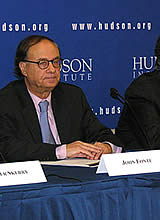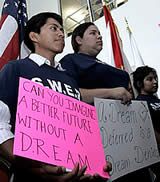
by Tommaso Verderame, 16, Michelle Hu, 18, and Rebekah Taft, 18, Y-Press
For 10 years, immigration has been a contentious issue in the United States. In the early part of the decade, the Bush administration was prepared to offer mass amnesty to illegal immigrants. As governor of Texas he’d long been friendly with Mexico, and both he and then-Mexican President Vincente Fox supported a big amnesty and guest worker program.
Click here to read these profiles:
Jane Addams School for Democracy
St. Paul, MN
Latino Youth Collective
Indianapolis, IN
League of United Latin American Citizens
Longmont. CO - Chapter
"All the immigrants were going to be legalized, and there was very little opposition," said John Fonte, director of the Center for American Common Culture at the Hudson Institute.
On Sept. 11, 2001, all of that changed. When it was reported that some of the terrorists were foreign visitors who had overstayed their visas, Americans became much more concerned about national security than legalizing immigrants. The U.S. borders were closed, and public opinion of illegal aliens became increasingly negative.
"The mood shifted, although there was still demand for cheap labor, and it came from businesses," said Fonte.
Since that time, the American public has largely opposed the legalization of undocumented immigrants, defeating reform bills by the Bush administration in 2006 and 2007. That hasn’t stemmed the tide of immigrants, however.
A million immigrants a year
According to the Hudson Institute, based in D.C., the United States allows more than a million immigrants to enter the country each year, which is more than any other country and half of all the immigrants in the world. This number doesn’t include illegal immigrants, who are estimated at more than 300,000, according to the Center for Immigration Studies, a nonpartisan, nonprofit research organization.
Because of these numbers, the issue of immigration is both politically and emotionally charged as activists see the nation changing before their eyes. On one side, concerned citizens advocate stricter border controls in order to protect the country and the environment from reaching a population overload. On the other, people whose families have managed to find their way to this country, either legally or illegally, are seeking better lives for themselves and want to provide the same opportunities for others.
While both viewpoints have supporters across the political spectrum, they share one trait: “Passions can get aroused quite easily on both sides,” says Laureen Laglagaron, policy analyst at the Migration Policy Institute in Washington, an independent think tank that analyzes international immigration patterns.
Immigration debates and youth activism
Despite its history of controversy, immigration has failed to draw youth activists unless they have a personal reason to participate. Typically, the youth who are most active are the ones whose relatives or friends have benefited or stand to benefit from it, although many youth are sympathetic to individuals who are working for a better life.
For example, service-minded youth routinely reach out to help immigrant families in their communities, said Elisa Barety of Exodus, a refugee resettlement agency in Indianapolis. "We have youth from the community who are involved in helping teach English classes and teach our new families about different aspects of American life," she said. "We had a group of Girl Scouts come and do little Christmas packets for some of our families."
This natural sympathy for the underdog works against youth involvement on the conservative side of immigration reform, says Bob Dane, communications director for the Federation for American Immigration Reform in Washington, D.C., the nation’s largest nonpartisan immigration reform group, which advocates for stronger borders and stricter immigration laws.
“The immigration debate is difficult to get younger folks excited about because they always view it as, ‘Oh we’re the bad guys keeping out the good guys who are trying to come into the country just to make a better life for themselves,’” he said. “Immigration always looks good from one particular individual’s story.”
But sympathy doesn’t usually translate into action, according to Ana Perez of the Central American Resource Center in San Francisco. Perez and her family escaped from the civil war in El Salvador in the 1980s, and she now supports immigrant families in the Bay Area.
Perez works with local youth to enhance their leadership skills and often comes in contact with youth from mixed-documentation families— families where parents have differing legal statuses—and for them, “issues of immigration are about not having one of their parents deported or they themselves not being deported.”
And though she sees few youth unaffected by immigration issues involve in reform activism, many do support those dealing with deportation problems. “As a whole, youth of color tend to be much more sympathetic,” she said.
The DREAM Act
Nonetheless, one issue in particular seems to be galvanizing youth today. The Development, Relief and Education of Alien Minors Act, introduced in the U.S. Senate and the House of Representatives on March 26, has found many supporters in schools and on college campuses.
The DREAM Act, as it is dubbed, would grant “conditional legal status” to illegal immigrant youth who, among other things, are of “good moral character,” have been in the country continuously for at least five years and are actively pursuing an education. As a bipartisan bill, it is intended to promote the education of undocumented youth by dropping some of the impediments that they now face in applying for and attending college and in securing jobs afterward.
Hugely popular with immigrant youth, the DREAM Act has become probably the biggest focus of youth activism in immigration. But again, the most active proponents are those most likely to benefit from it. “I think the DREAM Act has allowed youth activism to express their point of view,” Laglagaron said. “It’s been a way for people who might not be familiar with immigration issues generally to start to notice immigration issues because they’re in class with someone who is undocumented or who is asking them to sign a petition,” she said.
For youth activists—whether on behalf of immigration reform or some other issue—being tech savvy has made all the difference in the world. “Those are the voices that are being heard through media,” says Cari Morales, a sophomore at Indiana University who has been active on Latino issues.
Morales said she used to take media and technology for granted, seeing them more as mere entertainment rather than as rallying forces. “I think we’re all aware of the media, but we’re unconscious that we’re aware of it,” she said.
Using technology comes naturally to today’s youth and is generally the first thing they turn to when seeking support for a cause. “New technology really encourages youth to mobilize quickly and so youth are able to turn out to places a lot faster than grown-ups,” said Perez.




